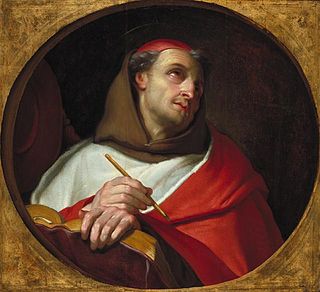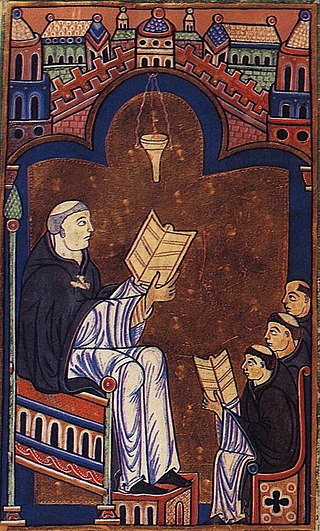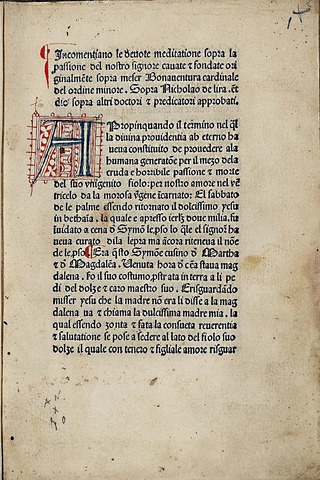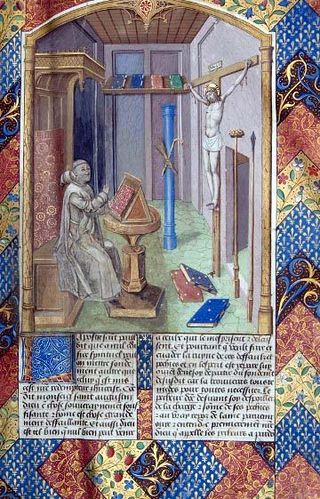
Bonaventure was an Italian Catholic Franciscan bishop, cardinal, scholastic theologian and philosopher.
Bernardus Silvestris, also known as Bernard Silvestris and Bernard Silvester, was a medieval Platonist philosopher and poet of the 12th century.
Middle English Bible translations (1066-1500) covers the age of Middle English, beginning with the Norman conquest and ending about 1500.

Pseudepigrapha are falsely attributed works, texts whose claimed author is not the true author, or a work whose real author attributed it to a figure of the past. The name of the author to whom the work is falsely attributed is often prefixed with the particle "pseudo-", such as for example "pseudo-Aristotle" or "pseudo-Dionysius": these terms refer to the anonymous authors of works falsely attributed to Aristotle and Dionysius the Areopagite, respectively.

Wycliffe's Bible or Wycliffite Bibles or Wycliffian Bibles (WYC) are names given for a sequence of Middle English Bible translations believed to have been made under the direction or instigation of English theologian John Wycliffe of the University of Oxford. They are the earliest known literal translations of the entire Bible into English. They appeared over a period from approximately 1382 to 1395.
Dominicus Gundissalinus, also known as Domingo Gundisalvi or Gundisalvo, was a philosopher and translator of Arabic to Medieval Latin active in Toledo. Among his translations, Gundissalinus worked on Avicenna's Liber de philosophia prima and De anima, Ibn Gabirol's Fons vitae, and al-Ghazali's Summa theoricae philosophiae, in collaboration with the Jewish philosopher Abraham Ibn Daud and Johannes Hispanus. As a philosopher, Gundissalinus crucially contributed to the Latin assimilation of Arabic philosophy, being the first Latin thinker in receiving and developing doctrines, such as Avicenna's modal ontology or Ibn Gabirol's universal hylomorphism, that would soon be integrated into the thirteenth-century philosophical debate.

Richard Rolle was an English hermit, mystic, and religious writer. He is also known as Richard Rolle of Hampole or de Hampole, since at the end of his life he lived near a Cistercian nunnery in Hampole, now in South Yorkshire. In the words of Nicholas Watson, scholarly research has shown that "[d]uring the fifteenth century he was one of the most widely read of English writers, whose works survive in nearly four hundred English ... and at least seventy Continental manuscripts, almost all written between 1390 and 1500." In many ways, he can be considered the first English author, insofar as his vernacular works were widely considered to have considerable religious authority and influence soon after his death, and for centuries afterwards.
De duodecim abusivis saeculi, also titled simply De duodecim abusivis, is a Hiberno-Latin treatise on social and political morality written by an anonymous Irish author between 630 and 700, or between 630 and 650. During the Middle Ages, the work was very popular throughout Europe.

Hugh of Saint Victor was a Saxon canon regular and a leading theologian and writer on mystical theology.

Petrus Comestor, also called Pierre le Mangeur, was a twelfth-century French theological writer and university teacher.
Walter Hilton, Can. Reg. was an English Augustinian mystic, whose works gained influence in 15th-century England and Wales. He is commemorated by the Church of England and by the Episcopal Church in the United States.
Pseudo-Plutarch is the conventional name given to the actual, but unknown, authors of a number of pseudepigrapha attributed to Plutarch but now known to have not been written by him.
Life of Soul is a short anonymous prose tract written in the late Middle English of the English Midlands about 1400 or a little earlier.

Thomas Gallus of Vercelli, sometimes in early twentieth century texts called Thomas of St Victor, Thomas of Vercelli or Thomas Vercellensis, was a French theologian, a member of the School of St Victor. He is known for his commentaries on Pseudo-Dionysius and his ideas on affective theology. His elaborate mystical schemata influenced Bonaventure and The Cloud of Unknowing.
Nicholas Love, also known as Nicholas Luff, was first a Benedictine and then a Carthusian monk in medieval England, and became the first prior of Mount Grace charterhouse in Yorkshire. He was the translator and reviser of a popular devotional treatise which was used by the Church authorities to counter the teaching of John Wycliffe. In his later years he convinced Henry V of England to attempt to reform Benedictine monasticism in England, but died before measures could be taken.

The Meditations on the Life of Christ is a fourteenth-century devotional work, later translated into Middle English by Nicholas Love as The Mirror of the Blessed Life of Jesus Christ.
The Collationes in Hexaemeron are an unfinished series of theological lectures given by St. Bonaventure in Paris between Easter and Pentecost 1273.

The Vita Christi, also known as the Speculum vitae Christi is the principal work of Ludolph of Saxony, completed in 1374.
Pseudo-Augustine is the name given by scholars to the authors, collectively, of works falsely attributed to Augustine of Hippo. Augustine himself in his Retractiones lists many of his works, while his disciple Possidius tried to provide a complete list in his Indiculus. Despite this check, false attributions to Augustine abound.

Affective piety is most commonly described as a style of highly emotional devotion to the humanity of Jesus, particularly in his infancy and his death, and to the joys and sorrows of the Virgin Mary. It was a major influence on many varieties of devotional literature in late-medieval Europe, both in Latin and in the vernaculars. This practice of prayer, reading, and meditation was often cultivated through visualization and concentration on vivid images of scenes from the Bible, Saints' Lives, Virgin Mary, Christ and religious symbols, feeling from the result. These images could be either conjured up in people's minds when they read or heard poetry and other pieces of religious literature, or they could gaze on manuscript illuminations and other pieces of art as they prayed and meditated on the scenes depicted. In either case, this style of affective meditation asked the "viewer" to engage with the scene as if she or he were physically present and to stir up feelings of love, fear, grief, and/or repentance for sin.










